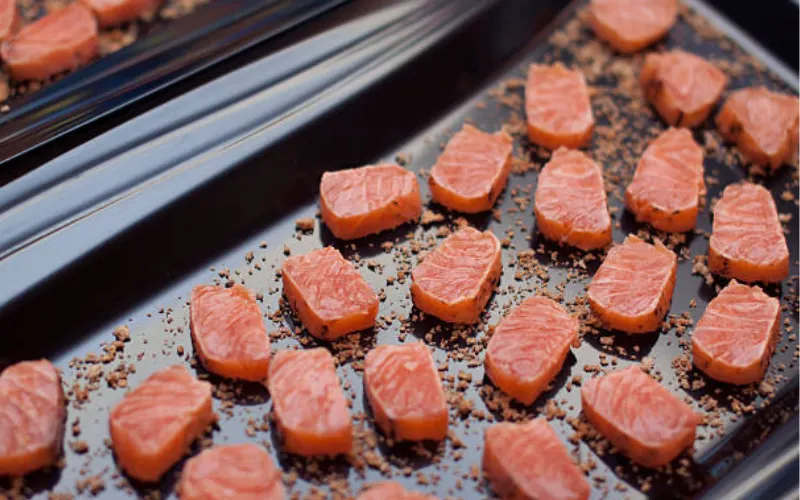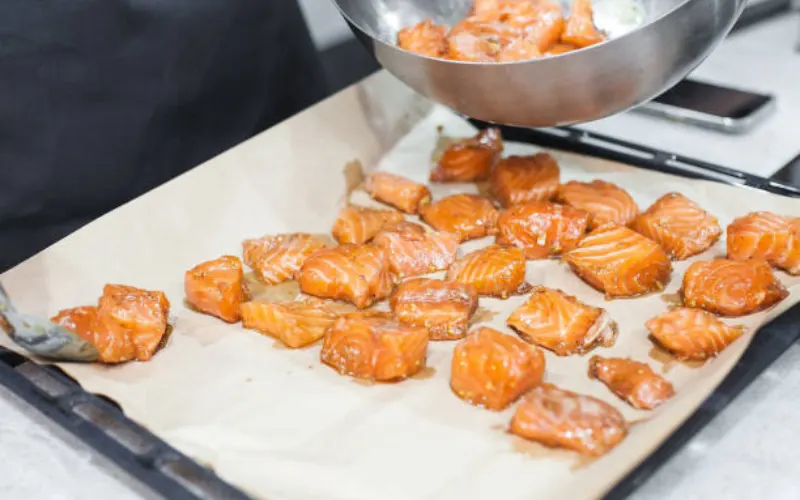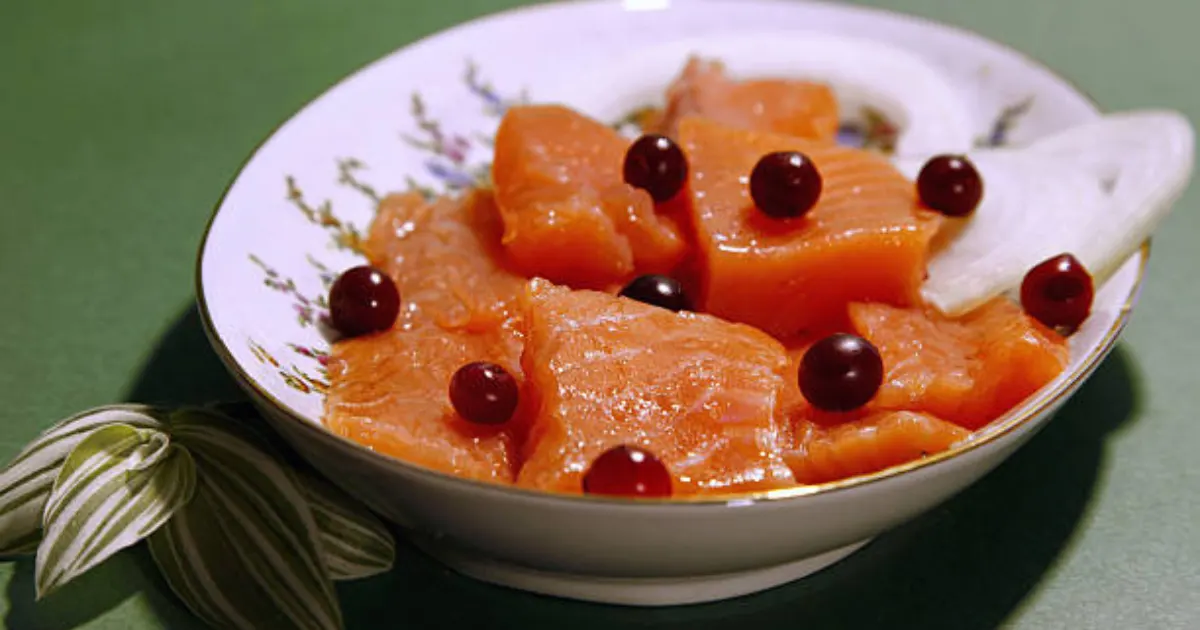Irresistible Salmon Candy Recipe: 7 Secrets to Sweet and Savory Perfection!
Did you know that salmon candy recipe has been a traditional preservation method for Pacific Northwest Indigenous peoples for thousands of years, with modern variations now appearing in gourmet food stores at up to $40 per pound? This sweet-savory salmon candy recipe transforms ordinary salmon into irresistible jerky-like treats that balance rich umami flavors with caramelized sweetness. Whether you’re looking to preserve a bountiful catch or simply craving a protein-packed snack with complex flavors, this salmon candy recipe delivers an unforgettable taste experience that celebrates the Pacific Northwest’s culinary heritage while adding modern twists.
Table of Contents

Ingredients List
For this mouthwatering salmon candy recipe, you’ll need:
- 2 pounds fresh salmon fillets (preferably sockeye or king salmon)
- 1 cup brown sugar (dark or light)
- 1/3 cup kosher salt
- 2 tablespoons garlic powder
- 1 tablespoon black pepper
- 1/4 cup maple syrup (real, not artificial)
- 2 tablespoons soy sauce
- 1 tablespoon liquid smoke (optional)
- 1 teaspoon cayenne pepper (optional, for heat)
Substitution options:
- Honey or agave nectar can replace maple syrup
- Coconut sugar can substitute for brown sugar
- Tamari or coconut aminos work well in place of soy sauce
- Smoked paprika can replace liquid smoke for a similar flavor profile
Timing
- Preparation time: 30 minutes (plus 8-12 hours for curing)
- Cooking time: 3-4 hours
- Total time: 12-16 hours (including curing time)
This recipe’s active preparation time is approximately 40% less than traditional methods that often require 24+ hours of processing time. The hands-on work is minimal, allowing you to tend to other tasks while the salmon transforms into candy-like morsels.

Step-by-Step Instructions
Step 1: Select and Prepare the Salmon
Remove all pin bones from your salmon fillets using tweezers or needle-nose pliers. For the best results, partially freeze the salmon (about 20 minutes in the freezer) to make it easier to slice. Cut the salmon into strips about 1-inch wide and 4-5 inches long, cutting against the grain for a better texture. Keep the skin on to help hold the pieces together during cooking.
Step 2: Create the Curing Mixture
In a large bowl, combine the brown sugar, kosher salt, garlic powder, and black pepper. Mix thoroughly until all ingredients are well incorporated. This dry brine will draw moisture from the salmon while infusing it with flavor, creating the perfect foundation for your candy.
Step 3: Apply the Cure
Place a layer of the curing mixture at the bottom of a glass or non-reactive container. Lay salmon strips on top, ensuring they don’t overlap. Cover completely with more cure mixture. Continue layering until all salmon is covered. Cover the container and refrigerate for 8-12 hours (overnight works perfectly).
Step 4: Rinse and Dry
After curing, remove the salmon from the refrigerator and rinse each piece thoroughly under cold water to remove excess salt and sugar. Pat dry with paper towels. Arrange the pieces on a wire rack and allow them to air dry for about 1 hour until a slightly tacky pellicle (surface layer) forms – this is crucial for the smoke flavoring to adhere properly.
Step 5: Prepare the Glaze
While the salmon is drying, mix the maple syrup, soy sauce, and liquid smoke (if using) in a small bowl. For those who enjoy a spicy kick, add the cayenne pepper to the glaze. This sweet-savory mixture will create that signature candy-like exterior.
Step 6: Smoke or Bake the Salmon
For smoking: Prepare your smoker to 165°F (74°C). Smoke the salmon for 3-4 hours, brushing with the glaze every hour.
For oven method: Preheat your oven to 175°F (80°C). Place the salmon on a wire rack set over a foil-lined baking sheet to catch drippings. Bake for 3-4 hours, brushing with the glaze every hour.
The salmon is ready when it feels firm but still slightly pliable – think of the texture of beef jerky with a bit more give.
Step 7: Cool and Store
Allow the salmon candy to cool completely on the racks. The pieces will firm up slightly as they cool. Once at room temperature, your salmon candy is ready to enjoy. For the best flavor development, wait 24 hours before eating.
Nutritional Information
Per 2-oz serving (approximately 3-4 pieces):
- Calories: 180
- Protein: 18g
- Fat: 8g (Healthy omega-3 fatty acids: 1.8g)
- Carbohydrates: 10g
- Sugar: 9g
- Sodium: 430mg
- Vitamin D: 80% of Daily Value
- Calcium: 6% of Daily Value
- Iron: 8% of Daily Value
Salmon candy provides 32% more protein per ounce than traditional beef jerky while delivering essential omega-3 fatty acids that support heart and brain health.
Healthier Alternatives for the Salmon Candy Recipe
Looking to make this salmon candy recipe even healthier? Consider these modifications:
- Reduce the sugar content by cutting the brown sugar to 1/2 cup and using stevia or monk fruit sweetener to supplement sweetness
- Use low-sodium soy sauce to reduce the overall salt content by approximately 40%
- Add citrus zest (orange or lemon) to the cure for bright flavor without additional calories
- Incorporate anti-inflammatory spices like turmeric (1 teaspoon) and black pepper (enhances turmeric absorption)
- Replace part of the salt with celery seed, which provides natural sodium flavor with additional health benefits
- For those monitoring sugar intake, use sugar-free maple-flavored syrup combined with a small amount of real maple syrup for authentic flavor
Serving Suggestions
Transform your salmon candy into delightful culinary experiences with these serving ideas:
- Dice and fold into scrambled eggs for a protein-packed breakfast
- Add to a charcuterie board alongside aged cheeses and crackers
- Crumble over a salad of mixed greens, avocado, and citrus segments
- Serve as an appetizer with a side of wasabi-infused sour cream
- Include in a grain bowl with quinoa, roasted vegetables, and miso dressing
- Pair with a glass of crisp Riesling or Sauvignon Blanc for a sophisticated snack
- Add to fried rice or stir-fries for an umami flavor boost
For an impressive brunch option, create salmon candy eggs Benedict by substituting traditional Canadian bacon with your homemade salmon candy.
Common Mistakes to Avoid
Even experienced home cooks can encounter challenges when making salmon candy. Here’s how to avoid the most common pitfalls:
- Over-salting: The most frequent mistake is using too much salt or curing for too long. The salmon should be firm but not desiccated after curing. If your first batch is too salty, reduce the salt by 25% next time.
- Inconsistent slicing: Pieces of varying thickness will cook unevenly. Aim for uniform slices of about 1/4-inch thickness for the best results.
- Insufficient drying: Skipping the pellicle formation leads to poor smoke absorption and texture. The one-hour drying time is essential for developing that signature candy-like exterior.
- Temperature fluctuations: Maintaining a consistent low temperature is crucial. Cooking at too high a temperature will cook the salmon rather than gradually dehydrating it, resulting in a less desirable texture.
- Under-seasoning: Don’t be afraid of bold flavors. Salmon candy should have a prominent sweet-savory profile that intensifies as it dries.
Storing Tips for the Salmon Candy Recipe
Properly stored salmon candy will maintain its delicious flavor and texture for an extended period:
- Short-term storage: Refrigerate in an airtight container for up to 2 weeks. Place parchment paper between layers to prevent sticking.
- Long-term storage: For up to 3 months, vacuum seal portions and store in the refrigerator. Alternatively, freeze for up to 6 months in heavy-duty freezer bags with excess air removed.
- Room temperature: Properly dried salmon candy can be kept at room temperature for 1-2 days when hiking or traveling. For best preservation, ensure the moisture content is low enough (salmon should be quite firm).
- Rehydrating: If your salmon candy becomes too dry, place it in a container with a slice of apple overnight in the refrigerator to restore some moisture.
Pro tip: Separate your batch into smaller portions for storage to avoid repeatedly exposing the entire batch to air when retrieving pieces.
Conclusion
This salmon candy recipe transforms ordinary salmon into extraordinary sweet-savory treats that balance rich umami flavors with caramelized sweetness. The technique, while requiring patience, rewards you with versatile, protein-rich morsels perfect for snacking, entertaining, or enhancing meals. The flavor complexity and satisfying texture make this recipe worth the wait and minimal hands-on effort.
Ready to create your own batch of mouthwatering salmon candy? Give this recipe a try and share your results in the comments section below! Subscribe to our blog for more unique preservation techniques and Pacific Northwest-inspired recipes that celebrate seasonal ingredients.
FAQs
Q: Can I use frozen salmon for this salmon candy recipe? A: Yes, frozen salmon works well. Thaw it completely in the refrigerator, not at room temperature, and pat it dry before proceeding with the recipe. High-quality frozen salmon often yields results comparable to fresh.
Q: How do I know when my salmon candy is properly finished? A: Properly finished salmon candy should be firm but slightly pliable, similar to soft leather. When bent, it should flex without breaking immediately. The surface should be glossy from the glaze, and the color should be a deep reddish-brown.
Q: Is salmon candy safe to eat without cooking to high temperatures? A: The combination of salt curing and low-temperature cooking creates a preserved product that is safe to consume. The salt inhibits bacterial growth, while the slow cooking process reduces moisture content to levels that prevent spoilage.
Q: Can I make salmon candy without a smoker? A: Absolutely! The oven method produces excellent results. To enhance the smoky flavor without a smoker, increase the liquid smoke in the glaze or add 1 teaspoon of smoked paprika to the dry cure mixture.
Q: How can I reduce the saltiness if my salmon candy turned out too salty? A: If your finished salmon candy is too salty, soak the next batch in cold water for 30 minutes after the curing process, then rinse thoroughly before drying. For already prepared candy, serving it with something sweet like a honey drizzle can help balance the saltiness.
Q: What’s the best type of salmon to use for salmon candy? A: Sockeye and king (Chinook) salmon are ideal due to their higher oil content, which produces moister, more flavorful candy. Coho is also good, while pink or chum salmon will work but yield a drier product. Wild-caught salmon typically offers better flavor than farmed options.
Q: Can I add other flavors to my salmon candy recipe? A: Absolutely! Try adding 1 tablespoon of grated ginger, 1 teaspoon of crushed fennel seeds, citrus zest, or even a tablespoon of bourbon to the glaze for creative variations that personalize your salmon candy.


